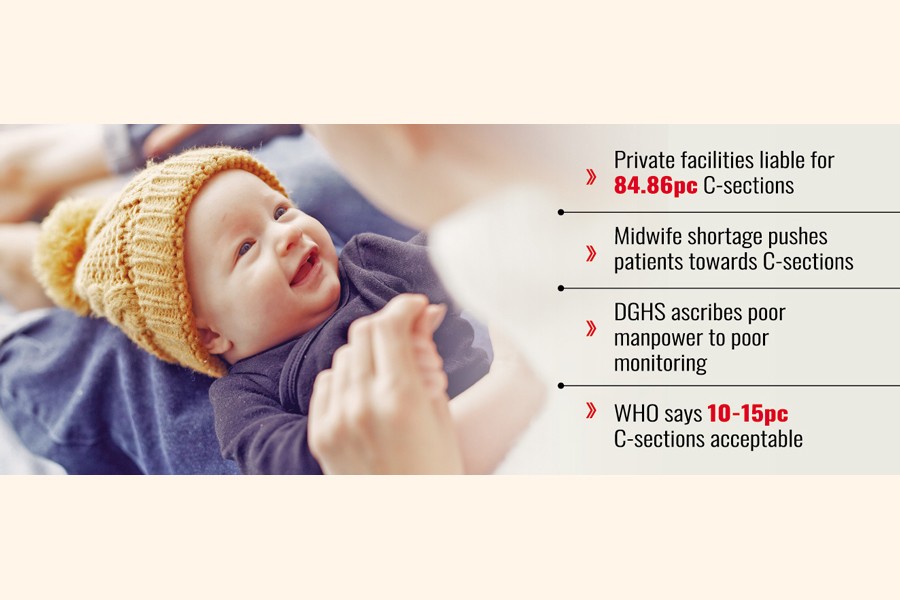
Three out of five births thru C-section in cities
SM NAJMUS SAKIB | Tuesday, 27 February 2024

The latest local demographic surveillance has found an alarming tendency of C-sections in Bangladesh with the private hospitals in the lead for lack of monitoring from the regulator's end.
City corporation areas see about three out of five births (58.21 per cent) given through C-Section.
Another startling revelation is that private health facilities are responsible for 84.86 per cent C-section out of their total deliveries.
At national level, more than two out of five births (41.37 per cent) are done through C-section, according to the Bangladesh Sample Vital Statistics 2022.
This picture is grimmer than that of a global one. According to the World Health Organisation (WHO), 10 to 15 per cent of C-sections are acceptable.
Vaginal birth is the most ideal and most frequently recommended birth method in most circumstances, according to the survey.
However, C-sections are meant to be reserved for situations when a natural delivery is not possible or if the health of a mother or a child is in danger.
It is 51.00 per cent in municipal and other urban areas. The scenario is a bit lower in rural areas (38.46 per cent).
Khulna division is leading in C-section delivery with 57.85 per cent, while Sylhet division is leading in normal delivery with 73.83 per cent.
On the other hand, public or government facilities make 54.70 per cent of their total deliveries through C-sections followed by NGO facilities with 40.03 per cent C-sections of their cases.
A mother's educational background is negatively correlated with the likelihood of a C-section because women with higher educational backgrounds are more likely to deliver through C-sections, finds the survey.
Syed Abdul Hamid, a professor of the Institute of Health Economics at Dhaka University, pointed a finger to the flawed health system.
"C-section is supposed to be performed only if it's clinically required, but we see its rise due to patients' demand and commercial mindset of private hospitals," he told the FE.
Citing that doctors have a role to play, he said owners of private hospitals are businessmen and they provide incentives to doctors to promote C-section.
Lax regulatory monitoring remains a major cause of this alarming rise, as he suggested examining C-section cases whether those were clinically required in order to gauge the situation on the ground.
Prof Dr ABM Khurshid Alam, director general of the Directorate General of the Health Services (DGHS), also said the number of C-sections was alarmingly high countrywide.
"We have directives to ensure the normal delivery protocol at every stage and every healthcare facility," he told the FE.
"But we don't have adequate manpower for monitoring on the ground if the regulation is being followed. Furthermore, we have a lack of adequate midwives at government facilities for 24/7 service," he lamented.
Of the total births, 28.3 per cent of the births took place at home within sample areas which are slightly lower than in 2021 of 35.2 per cent, according to the survey.
The survey said only 48.8 per cent of the deliveries attended by qualified physicians/doctors, 11.6 per cent births attended by nurses and only 1.3 per cent births were attended by professional educated midwives.
The government needs an additional 5,000 midwives immediately.
"How can I oversee the situation on the ground, if I don't have required manpower," the DGHS boss lamented saying that he already forwarded his demand (manpower, midwives) to the ministries concerned - health, finance and public administration in 2020 and still awaiting. For vaginal births, it is mandatory to encourage institutional delivery, he added.
Admitting the commercial mindset behind the increasing number of C-Sections, he added that patients often prefer C-sections to avoid labour pain.
According to Bangladesh Nursing and Midwifery Council (BNMC) data, the country has a total of 7,235 registered midwives.
But half of them are not employed as there are only about 3,000 posts of midwives at government facilities.
According to the previous Bangladesh Demographic and Health Survey 2023, it said the C-section rate jumped to 45 per cent in 2022 from 34 per cent in 2017.
It was 24 per cent in 2014 and 18 per cent in 2011.